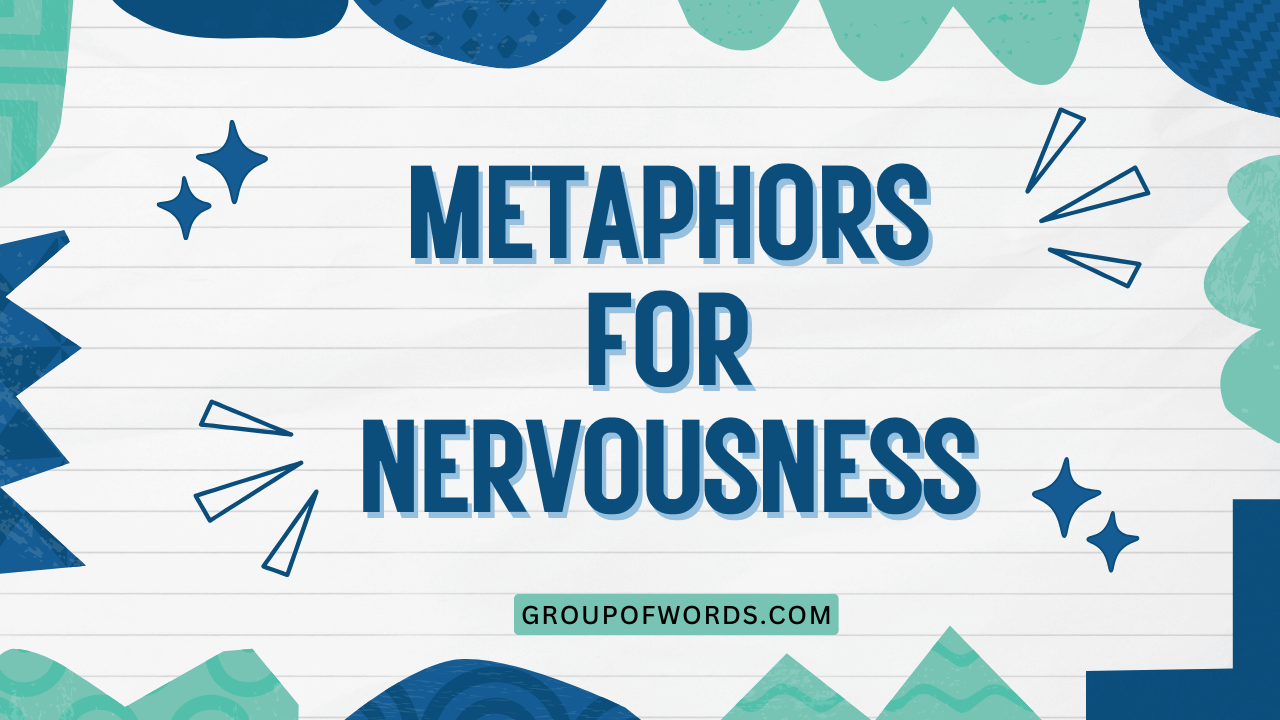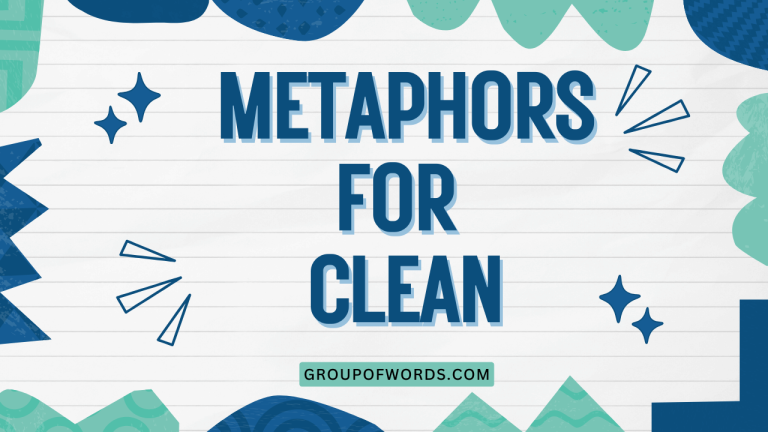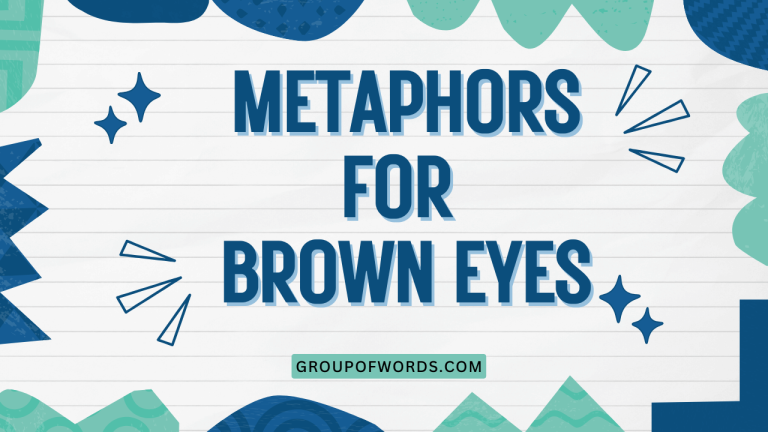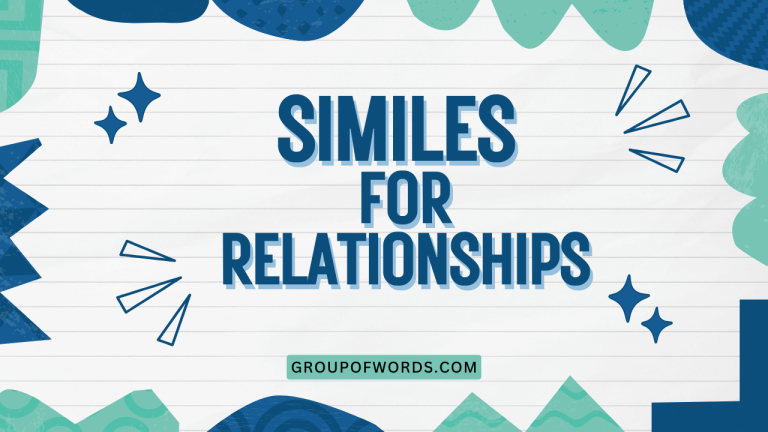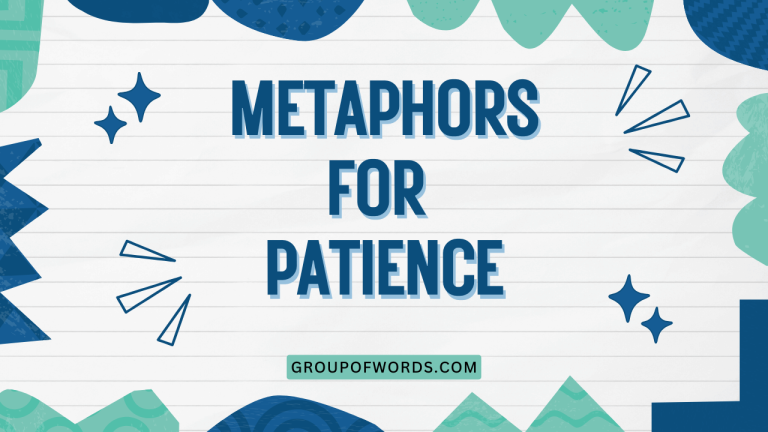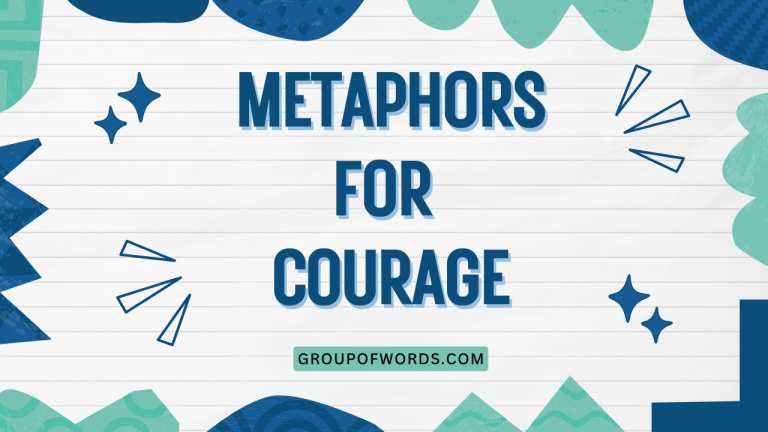Metaphors for Nervousness: Expressing Anxiety with Figurative Language
Nervousness is a universal human experience, but describing it can sometimes be challenging. Metaphors offer a powerful way to convey the complex physical and emotional sensations associated with anxiety.
By using figurative language, we can paint vivid pictures and help others understand the intensity of our feelings. This article explores a wide range of metaphors for nervousness, providing examples, explanations, and exercises to enhance your understanding and use of these expressive tools.
Whether you’re an English language learner, a writer seeking more descriptive language, or simply someone interested in the nuances of expression, this guide will equip you with the knowledge to articulate nervousness in creative and impactful ways.
Understanding metaphors for nervousness is crucial for both effective communication and a deeper understanding of emotional expression. This knowledge is beneficial for students, writers, public speakers, and anyone who wants to better articulate their feelings.
By mastering these metaphors, you can add depth and color to your language, making your communication more engaging and relatable.
Table of Contents
- Definition of Metaphor and Its Role in Describing Nervousness
- Structural Breakdown of Nervousness Metaphors
- Types and Categories of Metaphors for Nervousness
- Examples of Metaphors for Nervousness
- Usage Rules for Effective Metaphorical Language
- Common Mistakes When Using Metaphors for Nervousness
- Practice Exercises
- Advanced Topics: Nuances and Subtleties
- Frequently Asked Questions
- Conclusion
Definition of Metaphor and Its Role in Describing Nervousness
A metaphor is a figure of speech that directly compares two unrelated things, asserting that one thing *is* another, not just that it is *like* it (that would be a simile). Unlike similes, which use words like “like” or “as” to draw comparisons, metaphors make a direct equation. Metaphors are powerful tools for conveying complex emotions and experiences in a vivid and relatable way. They work by transferring qualities or characteristics from one concept (the source) to another (the target).
In the context of nervousness, metaphors allow us to express the often-intangible feelings of anxiety and unease through more concrete and understandable terms. For example, instead of simply stating “I am nervous,” you might say “My stomach is a butterfly farm,” which creates a more compelling and evocative image of the physical sensations associated with nervousness.
Metaphors tap into our shared experiences and sensory understanding, allowing for a deeper connection between the speaker and the listener.
Structural Breakdown of Nervousness Metaphors
Understanding the structure of a metaphor helps in crafting and interpreting them effectively. A metaphor typically consists of two key elements: the tenor (or topic) and the vehicle. The tenor is the subject being described (in our case, nervousness), and the vehicle is the object or concept used to describe it. The connection between the tenor and vehicle is the shared characteristic or quality that allows the metaphor to work.
Let’s break down the example “My stomach is a butterfly farm.” Here:
* Tenor: Nervousness (specifically the feeling in the stomach)
* Vehicle: A butterfly farm (a place with many butterflies fluttering around)
* Shared Characteristic: A fluttering, uneasy feeling
The effectiveness of a metaphor depends on the strength and relevance of the shared characteristic. A well-chosen vehicle will resonate with the audience and create a clear and impactful image of the tenor.
Consider the following elements when constructing metaphors for nervousness:
- Sensory Details: Engage the senses (sight, sound, touch, taste, smell) to create a more vivid and relatable experience.
- Emotional Resonance: Choose vehicles that evoke similar emotions to nervousness, such as fear, unease, or excitement.
- Contextual Appropriateness: Ensure the metaphor is appropriate for the specific situation and audience.
Types and Categories of Metaphors for Nervousness
Metaphors for nervousness can be grouped into several categories based on the type of imagery they employ. Understanding these categories can help you choose the most effective metaphor for a given situation.
Metaphors Based on Physical Sensations
These metaphors describe nervousness by comparing it to specific physical sensations. This is a common approach because nervousness often manifests in physical symptoms.
Examples include:
- My hands were ice.
- My throat was a desert.
- My heart was a drum solo.
- My legs felt like lead.
Animalistic Metaphors
These metaphors use animals to represent the feeling of nervousness, often drawing on the animal’s known characteristics or behaviors.
Examples include:
- I felt like a caged tiger.
- Butterflies in my stomach.
- I was a deer caught in headlights.
- I felt like a cornered rat.
Weather Metaphors
These metaphors use weather phenomena to describe the intensity and unpredictability of nervousness.
Examples include:
- A storm was brewing inside me.
- I felt like a hurricane was tearing through me.
- My mind was a fog.
- The anxiety was a torrential downpour.
Mechanical Metaphors
These metaphors compare nervousness to the malfunction or erratic behavior of machines.
Examples include:
- My mind was racing like an engine.
- I felt like a broken record.
- My thoughts were short-circuiting.
- I was running on fumes.
Environmental Metaphors
These metaphors use elements of the natural environment to describe the feeling of nervousness.
Examples include:
- I felt like I was sinking in quicksand.
- My mind was a tangled forest.
- I was walking on thin ice.
- The pressure was a crushing wave.
Examples of Metaphors for Nervousness
The following tables provide a variety of metaphors for nervousness, categorized by the type of image they evoke. These examples can serve as inspiration for your own writing and communication.
Table 1: Physical Sensation Metaphors for Nervousness
This table presents metaphors that use physical sensations to depict the feeling of nervousness. These metaphors often relate to common physical reactions to stress and anxiety.
| Metaphor | Explanation |
|---|---|
| My hands were ice. | Describes the cold, clammy feeling often associated with nervousness. |
| My throat was a desert. | Illustrates the dry, constricted feeling in the throat due to anxiety. |
| My heart was a drum solo. | Conveys the rapid, pounding heartbeat that can accompany nervousness. |
| My legs felt like lead. | Depicts the heavy, sluggish feeling in the legs caused by anxiety. |
| My stomach was doing somersaults. | Describes the churning, uneasy feeling in the stomach. |
| My skin was crawling. | Illustrates the sensation of unease and discomfort. |
| I felt like I had ants in my pants. | Conveys restlessness and an inability to sit still. |
| A cold sweat enveloped me. | Describes the sensation of sweating due to anxiety. |
| My muscles were coiled springs. | Illustrates the tension and readiness for action. |
| My breath hitched in my throat. | Describes the difficulty breathing caused by nervousness. |
| I felt a knot in my stomach. | Conveys the tight, uncomfortable sensation in the abdomen. |
| My head was pounding. | Illustrates the headache caused by stress and anxiety. |
| I felt like I was going to jump out of my skin. | Describes extreme unease and restlessness. |
| My palms were sweating profusely. | Depicts the clammy hands caused by nervousness. |
| My voice cracked with nervousness. | Illustrates the shaky voice caused by anxiety. |
| My vision tunneled. | Describes the narrowed focus and blurred vision caused by extreme nervousness. |
| I felt a chill run down my spine. | Conveys a sudden feeling of fear and unease. |
| My teeth were chattering. | Illustrates the shaking caused by extreme nervousness. |
| I felt like I was going to faint. | Describes the lightheadedness caused by extreme anxiety. |
| My face flushed with heat. | Depicts the redness and warmth caused by nervousness. |
| My body was trembling uncontrollably. | Illustrates the shaking caused by extreme anxiety. |
| My senses were heightened to an unbearable level. | Describes the feeling of being overly aware and sensitive. |
| I felt like I was vibrating with energy. | Conveys the restless and agitated feeling caused by nervousness. |
| My nerves were raw and exposed. | Illustrates the feeling of being overly sensitive and vulnerable. |
| My body felt like a tightly wound clock. | Describes the feeling of being tense and ready to snap. |
Table 2: Animalistic Metaphors for Nervousness
This table showcases metaphors that use animals to represent the feeling of nervousness. The characteristics of the animals are used to symbolize the anxiety.
| Metaphor | Explanation |
|---|---|
| I felt like a caged tiger. | Describes feeling trapped and restless with nervous energy. |
| Butterflies in my stomach. | A classic metaphor for the fluttering, uneasy feeling in the stomach. |
| I was a deer caught in headlights. | Conveys feeling frozen and helpless in a stressful situation. |
| I felt like a cornered rat. | Describes feeling trapped and desperate. |
| I was a fish out of water. | Illustrates feeling uncomfortable and out of place. |
| I felt like a hummingbird, vibrating with nervous energy. | Conveys the rapid, frantic energy of nervousness. |
| I was a scared rabbit, ready to bolt at any moment. | Describes feeling fearful and anxious to escape. |
| I felt like a coiled snake, ready to strike. | Illustrates tension and readiness for action. |
| I was a nervous cat, pacing back and forth. | Describes restless pacing and agitation. |
| I felt like a flock of birds had taken flight in my chest. | Conveys a sense of panic and fluttering anxiety. |
| I was a turtle hiding in its shell. | Illustrates a desire to withdraw and avoid confrontation. |
| I felt like a swarm of bees was buzzing in my head. | Describes a chaotic and overwhelming feeling. |
| I was a moth drawn to a flame, despite my fear. | Conveys a sense of irresistible attraction despite anxiety. |
| I felt like a trapped butterfly, beating against a window. | Illustrates feeling confined and desperate to escape. |
| I was a prairie dog, constantly scanning for danger. | Describes hyper-vigilance and constant anxiety. |
| My thoughts scattered like startled pigeons. | Describes the feeling of losing focus and control. |
| I felt like a caged bird longing for freedom. | Conveys a sense of restriction and desire to escape the stressful situation. |
| I was a lone wolf, isolated and anxious. | Illustrates feelings of isolation and loneliness. |
| I felt like a chameleon, trying to blend in to avoid attention. | Describes the desire to hide and avoid being noticed. |
| I was a frightened mouse, scurrying for cover. | Conveys a sense of fear and vulnerability. |
| My mind was like a squirrel hoarding nuts, filled with worries. | Illustrates the feeling of being overwhelmed with anxieties. |
| I felt like an owl, wide-eyed and alert with nervousness. | Describes a state of heightened awareness and anxiety. |
| I was a spider spinning a web of anxieties. | Conveys the feeling of being trapped in one’s own worries. |
| I felt like a fish on a hook, wriggling with discomfort. | Illustrates a sense of being trapped and helpless. |
| My nerves were like a pack of wild dogs, uncontrollable and chaotic. | Describes a feeling of overwhelming anxiety and lack of control. |
Table 3: Weather Metaphors for Nervousness
This table provides metaphors that utilize weather elements to describe the feeling of nervousness. These metaphors often relate to the intensity and unpredictability of anxiety.
| Metaphor | Explanation |
|---|---|
| A storm was brewing inside me. | Describes a build-up of anxiety and tension. |
| I felt like a hurricane was tearing through me. | Conveys the overwhelming and destructive force of anxiety. |
| My mind was a fog. | Illustrates the confusion and lack of clarity caused by nervousness. |
| The anxiety was a torrential downpour. | Describes an overwhelming and relentless feeling of anxiety. |
| I felt like I was walking through a dense fog of anxiety. | Conveys the feeling of being disoriented and lost in anxiety. |
| My thoughts were scattered like leaves in a whirlwind. | Describes the chaotic and uncontrollable nature of anxious thoughts. |
| A cloud of worry hung over me. | Illustrates a persistent and oppressive feeling of anxiety. |
| I felt like I was drowning in a sea of anxiety. | Conveys the overwhelming and suffocating nature of anxiety. |
| My heart was a thunderclap in my chest. | Describes the sudden and intense sensation of anxiety. |
| I felt like I was weathering a storm of emotions. | Conveys the feeling of enduring a difficult and challenging experience. |
| My mind was a dark and stormy night. | Illustrates the feeling of darkness and turmoil caused by anxiety. |
| I felt like I was caught in a blizzard of worry. | Describes the overwhelming and disorienting feeling of anxiety. |
| My anxiety was a slow, creeping fog. | Conveys the gradual and insidious nature of anxiety. |
| I felt like I was stuck in a perpetual drizzle of worry. | Describes a constant and persistent feeling of anxiety. |
| My thoughts were swirling like a tornado. | Illustrates the chaotic and destructive nature of anxious thoughts. |
| I felt like I was walking on thin ice, ready to crack at any moment. | Conveys the feeling of being in a precarious and dangerous situation. |
| My emotions were a tempest, raging out of control. | Describes the intense and uncontrollable nature of anxiety. |
| I felt like I was being swept away by a flood of anxiety. | Conveys the overwhelming and uncontrollable nature of anxiety. |
| My mind was a desert, parched with worry. | Illustrates the feeling of emptiness and desolation caused by anxiety. |
| I felt like I was being struck by lightning bolts of panic. | Describes the sudden and intense sensation of panic attacks. |
| My anxiety was a relentless tide, pulling me under. | Conveys the feeling of being overwhelmed and suffocated by anxiety. |
| I felt like I was lost in a dense, impenetrable forest of worry. | Illustrates the feeling of being lost and overwhelmed by anxiety. |
| My thoughts were like thunder, rumbling in the distance. | Describes the ominous and foreboding feeling of anxiety. |
| I felt like I was being battered by a relentless hailstorm of anxiety. | Conveys the intense and painful nature of anxiety. |
| My anxiety was a creeping frost, chilling me to the bone. | Describes the pervasive and chilling effect of anxiety. |
Table 4: Mechanical Metaphors for Nervousness
This table presents metaphors that use mechanical devices to depict the feeling of nervousness. These metaphors often relate to a sense of malfunction or being out of control.
| Metaphor | Explanation |
|---|---|
| My mind was racing like an engine. | Describes the rapid and uncontrollable thoughts associated with anxiety. |
| I felt like a broken record. | Conveys the feeling of being stuck in a repetitive loop of anxious thoughts. |
| My thoughts were short-circuiting. | Illustrates the feeling of mental confusion and disorganization. |
| I was running on fumes. | Describes feeling exhausted and depleted by anxiety. |
| I felt like my gears were grinding. | Conveys the feeling of mental friction and difficulty thinking clearly. |
| My mind was a runaway train. | Illustrates the feeling of being out of control and unable to stop anxious thoughts. |
| I felt like I was a robot malfunctioning. | Describes the feeling of being disconnected from one’s own body and emotions. |
| My thoughts were spinning like a broken gyroscope. | Conveys the feeling of being disoriented and unbalanced. |
| I felt like my battery was running low. | Describes feeling drained and lacking energy due to anxiety. |
| My mind was a tangled web of wires. | Illustrates the feeling of mental confusion and disorganization. |
| I felt like I was a machine on the verge of breaking down. | Conveys the feeling of being overwhelmed and unable to cope. |
| My thoughts were skipping like a scratched CD. | Describes the feeling of being unable to focus and concentrate. |
| I felt like I was a computer crashing. | Illustrates the feeling of mental overload and shutdown. |
| My mind was a noisy engine, sputtering and stalling. | Conveys the feeling of mental chaos and difficulty thinking clearly. |
| I felt like my circuits were overloaded. | Describes the feeling of being overwhelmed and unable to process information. |
| My thoughts were racing like a high-speed train off the rails. | Illustrates the feeling of being out of control and headed for disaster. |
| I felt like I was a machine running in overdrive. | Conveys the feeling of being constantly stressed and overworked. |
| My mind was a broken clock, ticking erratically. | Describes the feeling of being disoriented and out of sync. |
| I felt like I was a robot programmed to worry. | Illustrates the feeling of being trapped in a cycle of anxious thoughts. |
| My thoughts were like gears grinding against each other, creating friction. | Conveys the feeling of mental conflict and difficulty thinking clearly. |
| I felt like my internal engine was revving too high, about to blow. | Describes the feeling of being overly stressed and on the verge of a breakdown. |
| My mind was a jammed printer, spitting out errors. | Illustrates the feeling of being unable to function properly. |
| I felt like I was a machine with a loose screw, about to fall apart. | Conveys the feeling of being unstable and vulnerable. |
| My thoughts were like a broken record player, stuck on repeat. | Describes the feeling of being trapped in a loop of anxious thoughts. |
| I felt like my internal hard drive was overheating. | Illustrates the feeling of mental exhaustion and overload. |
Table 5: Environmental Metaphors for Nervousness
This table showcases metaphors that use elements of the natural environment to represent the feeling of nervousness. These metaphors often relate to a sense of being trapped, overwhelmed, or in danger.
| Metaphor | Explanation |
|---|---|
| I felt like I was sinking in quicksand. | Describes the feeling of being trapped and unable to escape anxiety. |
| My mind was a tangled forest. | Illustrates the feeling of being lost and confused in anxious thoughts. |
| I was walking on thin ice. | Conveys the feeling of being in a precarious and dangerous situation. |
| The pressure was a crushing wave. | Describes the overwhelming and suffocating feeling of anxiety. |
| I felt like I was trapped in a dense fog. | Illustrates the feeling of being disoriented and unable to see clearly. |
| My thoughts were swirling like sand in a desert storm. | Conveys the chaotic and uncontrollable nature of anxious thoughts. |
| I felt like I was drowning in a deep ocean of despair. | Describes the overwhelming and hopeless feeling of anxiety. |
| My mind was a barren wasteland. | Illustrates the feeling of emptiness and desolation caused by anxiety. |
| I felt like I was being swallowed by a dark abyss. | Conveys the feeling of being overwhelmed and consumed by anxiety. |
| My thoughts were like weeds, choking the life out of my mind. | Describes the destructive and pervasive nature of anxious thoughts. |
| I felt like I was trapped in a spiderweb of fear. | Illustrates the feeling of being ensnared and unable to escape anxiety. |
| My mind was a volcano, ready to erupt with anxiety. | Conveys the feeling of pent-up tension and impending explosion. |
| I felt like I was lost in a labyrinth of worry. | Describes the feeling of being confused and unable to find a way out of anxiety. |
| My thoughts were like thorns, pricking my mind with pain. | Illustrates the painful and irritating nature of anxious thoughts. |
| I felt like I was being buried alive by anxiety. | Conveys the feeling of being suffocated and overwhelmed by anxiety. |
| My mind was a swamp, filled with murky and unpleasant thoughts. | Describes the feeling of being stuck in a quagmire of anxiety. |
| I felt like I was trapped in a cage of my own making. | Illustrates the feeling of being confined and unable to break free from anxiety. |
| My thoughts were like poisonous vines, strangling my peace of mind. | Conveys the destructive and suffocating nature of anxious thoughts. |
| I felt like I was being swept away by a raging river of anxiety. | Describes the overwhelming and uncontrollable nature of anxiety. |
| My mind was a graveyard, filled with the ghosts of past worries. | Illustrates the feeling of being haunted by past anxieties. |
| I felt like I was walking through a field of landmines, ready to explode at any moment. | Conveys the feeling of being in a constant state of alert and anxiety. |
| My thoughts were like shards of glass, cutting my mind with pain. | Describes the sharp and painful nature of anxious thoughts. |
| I felt like I was being suffocated by a blanket of anxiety. | Illustrates the feeling of being overwhelmed and unable to breathe. |
| My mind was a maze, with no exit in sight. | Conveys the feeling of being lost and unable to find a solution to anxiety. |
| I felt like I was trapped in a whirlpool of negative thoughts. | Describes the cyclical and overwhelming nature of anxious thoughts. |
Usage Rules for Effective Metaphorical Language
To use metaphors effectively, consider the following rules:
- Clarity: Ensure the metaphor is understandable and relevant to your audience. Avoid obscure or overly complex comparisons.
- Originality: Strive for fresh and creative metaphors that will engage your readers or listeners. Avoid clichés.
- Consistency: Maintain the metaphor throughout the passage. Mixing metaphors can create confusion and weaken the impact.
- Appropriateness: Choose metaphors that are appropriate for the context and tone of your writing or speech.
- Relevance: The connection between the tenor and vehicle should be clear and meaningful. The shared characteristic should resonate with the audience.
Common Mistakes When Using Metaphors for Nervousness
Here are some common mistakes to avoid when using metaphors for nervousness:
1. Mixed Metaphors: Combining two or more incompatible metaphors.
| Incorrect | Correct |
|---|---|
| “My stomach was a butterfly farm, and I felt like I was drowning in a sea of anxiety.” | “My stomach was a butterfly farm.” OR “I felt like I was drowning in a sea of anxiety.” |
2. Clichés: Using overused and predictable metaphors.
| Incorrect | Correct |
|---|---|
| “I had butterflies in my stomach.” | “My stomach was aflutter with anticipation, like a thousand tiny wings beating against my insides.” |
3. Unclear Comparisons: Using metaphors that are difficult to understand or relate to.
| Incorrect | Correct |
|---|---|
| “My nervousness was a Fibonacci sequence.” | “My nervousness was a runaway train, gaining speed and heading for disaster.” |
4. Overly Complex Metaphors: Using metaphors that are too elaborate or convoluted.
| Incorrect | Correct |
|---|---|
| “My anxiety was like a Byzantine mosaic, each tiny piece of worry contributing to a vast and intricate pattern of unease.” | “My anxiety was a heavy weight, pressing down on my chest.” |
Practice Exercises
Test your understanding of metaphors for nervousness with these exercises.
Exercise 1: Identify the Metaphor
Identify the metaphor in each sentence and explain its meaning.
| Question | Answer |
|---|---|
| 1. My mind was a tangled forest of worries. | Metaphor: “tangled forest of worries.” Meaning: Describes a state of confusion and being lost in anxious thoughts. |
| 2. The pressure was a crushing wave. | Metaphor: “crushing wave.” Meaning: Conveys the overwhelming and suffocating feeling of anxiety. |
| 3. I felt like a broken record, repeating the same mistakes. | Metaphor: “broken record.” Meaning: Describes being stuck in a repetitive loop of anxious thoughts or behaviors. |
| 4. A storm was brewing inside me. | Metaphor: “storm was brewing.” Meaning: Illustrates a build-up of anxiety and tension. |
| 5. My heart was a drum solo, pounding in my chest. | Metaphor: “drum solo.” Meaning: Conveys the rapid and intense heartbeat caused by nervousness. |
| 6. My thoughts were scattered like leaves in a whirlwind. | Metaphor: “leaves in a whirlwind.” Meaning: Describes the chaotic and uncontrollable nature of anxious thoughts. |
| 7. I felt like I was sinking in quicksand of despair. | Metaphor: “sinking in quicksand.” Meaning: Conveys the feeling of being trapped and unable to escape anxiety. |
| 8. My anxiety was a relentless tide, pulling me under. | Metaphor: “relentless tide.” Meaning: Describes the overwhelming and suffocating nature of anxiety. |
| 9. The news hit me like a ton of bricks. | Metaphor: “ton of bricks.” Meaning: Conveys the overwhelming and shocking impact of the news. |
| 10. I felt like a caged tiger, pacing restlessly. | Metaphor: “caged tiger.” Meaning: Describes feeling trapped and restless with nervous energy. |
Exercise 2: Create Your Own Metaphors
Create your own metaphors for nervousness based on the following prompts:
| Prompt | Possible Answer |
|---|---|
| 1. Describe the feeling of anticipation before a big event. | My anticipation was a tightly wound spring, ready to release with explosive force. |
| 2. Describe the physical sensation of a panic attack. | A panic attack is a rogue wave crashing over me, stealing my breath and leaving me gasping for air. |
| 3. Describe the feeling of being overwhelmed by responsibilities. | Responsibilities are like vines, slowly but surely ensnaring me, until I can barely move. |
| 4. Describe the feeling of self-doubt. | Self-doubt is a persistent shadow, always lurking just behind me, whispering insidious lies. |
| 5. Describe the mental state when trying to focus while nervous. | Trying to focus while nervous is like trying to catch smoke with bare hands. |
| 6. Describe the feeling of vulnerability when facing a fear. | Facing a fear is like standing naked in a blizzard. |
| 7. Describe the feeling of being judged by others. | Being judged by others is like being placed under a microscope, every flaw magnified. |
| 8. Describe the feeling of being trapped by anxiety. | Being trapped by anxiety is like being buried alive under a mountain of worries. |
| 9. Describe the feeling of being constantly on edge. | Being constantly on edge is like walking a tightrope over a bottomless canyon. |
| 10. Describe the feeling of being overwhelmed by thoughts. | Being overwhelmed by thoughts is like being caught in a torrential downpour, unable to see or breathe. |
Advanced Topics: Nuances and Subtleties
At an advanced level, consider the following nuances and subtleties when using metaphors for nervousness:
- Subtext and Im
plicit Meaning: Metaphors can carry layers of meaning beyond the literal comparison. Consider the subtext and implicit associations of your chosen vehicle. For example, comparing nervousness to “walking on eggshells” implies not only anxiety but also a delicate and potentially volatile situation.
- Cultural Context: The effectiveness of a metaphor can depend on the cultural background of your audience. Some images may resonate more strongly or have different connotations in different cultures.
- Personal Experience: Drawing on personal experiences and observations can make your metaphors more unique and impactful. A metaphor rooted in a specific memory or sensory detail will often feel more authentic and relatable.
- Extended Metaphors: Developing a single metaphor over multiple sentences or paragraphs can create a powerful and cohesive image. This technique allows you to explore the nuances of nervousness in greater depth.
- Juxtaposition: Contrasting metaphors can create a sense of tension and complexity. For example, juxtaposing a mechanical metaphor (e.g., “My mind was racing like an engine”) with an environmental metaphor (e.g., “I felt like I was drowning in a sea of anxiety”) can highlight the conflicting aspects of the experience.
Frequently Asked Questions
What is the difference between a metaphor and a simile?
A metaphor directly equates two unrelated things (e.g., “My heart was a drum solo”), while a simile uses “like” or “as” to draw a comparison (e.g., “My heart was pounding like a drum”).
How can I avoid using clichés when creating metaphors?
Strive for originality by drawing on personal experiences, sensory details, and unexpected comparisons. Consider the unique aspects of nervousness and look for fresh ways to express them.
How do I choose the right metaphor for a specific situation?
Consider the context, audience, and tone of your writing or speech. Choose a metaphor that is clear, relevant, and appropriate for the situation.
Think about the specific aspects of nervousness you want to emphasize and select a vehicle that effectively conveys those qualities.
Can metaphors be used in formal writing?
Yes, metaphors can be used in formal writing, but it’s important to use them judiciously and ensure they are appropriate for the tone and audience. Avoid overly flamboyant or informal metaphors in formal contexts.
How can I improve my ability to create effective metaphors?
Practice regularly by observing the world around you and looking for connections between seemingly unrelated things. Read widely and pay attention to how other writers use metaphors.
Experiment with different types of imagery and solicit feedback from others.
Are there any cultural considerations when using metaphors?
Yes, metaphors can be culturally specific, and what resonates in one culture might not in another. Be mindful of your audience and consider whether your chosen metaphor will be understood and appreciated in their cultural context.
Some metaphors may even be offensive or inappropriate in certain cultures.
How can I use metaphors to better understand my own nervousness?
By exploring different metaphors for nervousness, you can gain a deeper understanding of your own experiences. Try journaling and experimenting with different ways to describe your feelings.
This process can help you identify the specific aspects of nervousness that are most salient for you and develop more effective coping strategies.
Conclusion
Metaphors are a powerful tool for expressing the complex and often elusive feeling of nervousness. By understanding the structure, types, and usage rules of metaphors, you can enhance your communication skills and connect with others on a deeper level.
Whether you’re a writer, speaker, or simply someone seeking to better understand your own emotions, mastering the art of metaphorical language will enrich your life and empower you to articulate your experiences with greater clarity and impact. So, embrace the power of figurative language and let your creativity soar as you explore the many ways to describe the multifaceted experience of nervousness.
